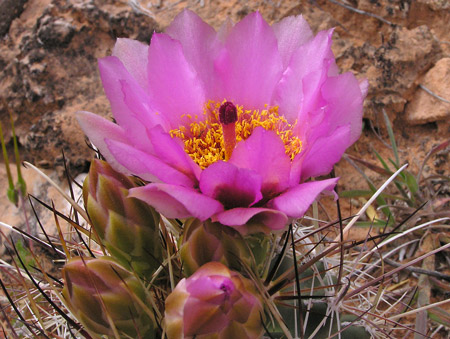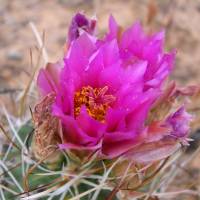Stems unbranched or branched near base, depressed-spheric, spheric, cylindric, or elongate-cylindric, 4.5-45 × 3.5-14.5 cm; ribs (10-)13(-16), tubercles evident on ribs. Spines frequently obscuring stems; radial spines 8-17 per areole, usually white, sometimes brown or purplish pink, 6-36 mm; central spines (3-)4-6(-8) per areole, 1-5 hooked; abaxial central spine usually purple black, hooked, 15-72 × 0.6-1 mm; lateral spines 2-6 per areole, similar to abaxial, usually shorter, usually not hooked; adaxial central spine usually white (rarely gray, straw colored, pink, or reddish brown), flat to angled or terete; straight (rarely contorted), 17-82(-90) × 0.7-1.5(-3) mm. Flowers funnelform to campanulate, (2-)3-5.7(-7) × 2.5-5.5(-8) cm; outer tepals with greenish or brownish purple midstripes and rose to purple, pink, yellow, or white margins, oblanceolate, 25-50 × 6-10 mm, mucronate, margins entire; inner tepals rose to purple, pink, or yellow (rarely white), oblanceolate, 15-55 × 6-12 mm, margins entire to fringed, apex mucronate; filaments purple, yellow, or green; anthers yellow; ovary papillate, appearing granular. Fruits irregularly dehiscent, green turning reddish pink, 10-30 × 10-15 mm; scales few, membranous fringed. Seeds dark brown to black, 2.5-3.5 × 1.5-3 mm; testa with rounded papillae.
Flowering late Apr-May. Sandy, gravelly, or clay hills, mesas, and washes, desert grasslands or saltbush, sagebrush, rabbitbrush, and blackbrush communities, pinyon-juniper woodlands; 1000-2100 m; Ariz., Colo., N.Mex., Utah.
Sclerocactus parviflorus has an extensive range and great morphologic variation. Many named segregates have been proposed (L. D. Benson 1982; K. D. Heil and J. M. Porter 1994; F. Hochstätter 1995b) and some of these clearly merit recognition at the subspecific or varietal level. However, we are not attempting to subdivide this very complex group. Considerable work remains in understanding morphologic diversification within this species.
Plant: STEMS solitary or clustered, depressed-globose to elongate-cylindrical, 5-27 cm long, 4.5-13 cm diameter; tubercles 1.5-2 cm apart
Leaves: SPINES dense, obscuring the stem, the central spines 4(-6), the lower central spine hooked, 1.5-7.2 cm long, 0.6-1 mm wide, white, yellow, brown, reddish-brown, pink to purplish-pink or black, the 2-4 laterals similar to the lower one, usually shorter, usually not hooked; the upper central 1.7-6.2 cm long, 0.7-1.5(-3) mm wide, mostly white, rarely gray, straw-yellow, pink, or reddish-brown, flat, rhombic or rounded in cross-section, rarely contorted; radial spines 3-17, 0.6-3.6 cm long, mostly white, but may be brown or purplish-pink
Flowers: 3-5.7 cm long, 2.5-5.5 cm in diameter; ovary granular-papillose; outer tepals oblanceolate, 2.5-4.5 cm long, 6-10 mm broad, with greenish or brownish-purple midribs and rose to purple, pink, yellow or white entire margins, mucronate; inner tepals oblanceolate, 1.5-5 cm long, 6-12 mm broad, rose to purple, pink, yellow or rarely white, mucronate; filaments purple, yellow, or green; style papillose, green or pink to purple; stigma lobes 5-10, purple or green
Fruit: FRUITS 1-2.5 cm long, 1-1.5 cm diameter, green turning reddish-pink, with a few membranous-fringed scales. SEEDS 1.5-3 mm long, 2.5-3.5 mm diameter, 1 mm thick, dark brown to black, covered by evenly spaced papillae
Misc: May-Jun
REFERENCES: Heil, Kenneth D., and Mark J. Porter. 2001. Cactaceae. J. Ariz. - Nev. Acad. Sci. Volume 33(1).
General: Hedgehog-type cactus, consisting of several stems in a cluster; stems depressed-globose to cylindric, 5-25 cm tall and 4-13 cm diameter, with about 13 ribs; tubercles (projections or bumps) evident along ribs.
Spines: Central spines 4-6 per areole, the lowest central spine prominently hooked, 1-7 cm long, other central spines shorter and rarely hooked; radial spines (spines emerging from the outside edge of the areole) 3-17 per areole, 6 mm to 4 cm long.
Flowers: Petals numerous, rose to pink, purple, yellow, or rarely white, 3-6 cm long and 1 cm wide; stamens many, with purple, yellow or green filaments, topped with yellow anthers.
Fruits: Fruits dry when mature, irregularly dehiscent (splitting open), 1-3 cm long, green when developing and drying reddish-pink; seeds dark brown to black, 3 mm wide.
Ecology: Found on sandy, gravelly, or clay hills, mesas, and washes, associated with desert grassland, saltbush, sagebrush, rabbitbrush, blackbrush, and pinyon-juniper vegetation communities, from 3,500-7,000 ft (1067-2134 m); flowers April-June.
Distribution: AZ, NM, UT, CO
Notes: This small cactus has a large range and great morphologic variation. It is fairly common in the four-corners region and identifiable by the single prominent fish hook-like spine in each spine cluster. The FNA treatment for the species (Heil and Porter 2004) does not attempt to sort out varieties or subspecies, but other work by the same authors (Vascular Plants of Arizona Project, 2001; Four Corners Flora 2013) recognizes 3 varieties in Arizona and the four-corners region. Var. parviflorus, in AZ, CO, and UT, has pink to pink-purple flowers, and the upper central spine is 1 mm wide. Var. intermedius, in NM, AZ, CO, and UT, has pink to pink-purple flowers and the upper central spine 2 mm wide. Var. terrae-canyonae is endemic to the San Juan River drainage in AZ and UT, and has yellow flowers. Distinguish S. parviflorus from the similar S. whipplei based on the flowers. S. whipplei has yellow flowers, 2-3 cm high; S. parviflorus has flowers 3-6 cm high, ranging from pink to yellow, depending on the variety. Echinocereus fendleri has a similar appearance and pink-purple flowers, but it lacks the single strongly hooked spine at each areole that S. parviflorus has.
Ethnobotany: Occasionally used as an ornamental.
Etymology: Sclerocactus from the Greek sclerao, cruel or obstinate, referring to the hooked spines; parviflorus translates to small flower.
Editor: AHazelton 2017








